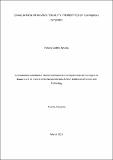| dc.description.abstract | Commiphora campestris leaves and stem bark are used by Pare society for management of infectious diseases, therefore this research evaluated in vivo toxicity of C. campestris. The leaves and stem bark were pulverized, sequentially extracted using chloroform, ethyl acetate and methanol and stored at -20°C. Three groups of mice (n=5/group/sex) were given oral dose of C. campestris extracts at 300, 600 and 1200 mg/kg. Clinical changes, body weight, mortality, relative organ weight, hematology and histopathological changes were recorded after 14 days. LD50 (424 mg/kg) was calculated by Lorke method. In acute tests mice showed behavioral changes, mortalities in both sexes given leaf methanolic, stem chloroform, stem ethyl acetate and stem methanol extract. Significant increase in hematological parameters (p>0.05) for males given leaf chloroform, stem ethyl acetate, stem chloroform extract and decrease in leaf methanolic, stem bark ethyl acetate and stem bark methanolic extract (p<0.05). Female mice that were given leaf chloroform and leaf ethyl acetate extract showed significant increase in hematology and decrease to those received leaf methanol, stem chloroform, stem ethyl acetate and stem methanol extract (p>0.05). In histopathology, kidneys showed increased glomerural space and distended liver sinusoids. In sub acute toxicity test, rats were given C. campestris extracts at doses 150, 200 and 250 mg/kg for 28 days. Body weight, relative organ weight, biochemical, hematological, biochemical and histopathological changes were determined. No mortality was recorded. Biochemical tests showed significant increase (p<0.05) in liver enzymes, hematological parameters and histological changes were distended liver sinusoids and kidney glomerural space. This study concludes that in acute toxicity study the extracts caused mortalities while in sub-acute toxicity study no mortalities were recorded and there was reduction in cholesterol levels indicating extracts antilipidemic effect, however more research to validate safety doses in humans is still needed. | en_US |

